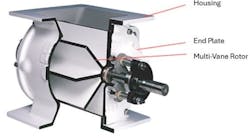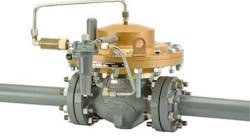Many were surprised to learn from data analyzed in recent years how much energy cost in a typical processing plant comes from keeping compressed air on-hand.
As a result, air compressor technology is aimed at improving energy efficiency and limiting air contamination and noise generation. As it has for years, oil-free air compression continues to gain market share.
"In process industry plants air is the fourth utility. It’s part of the process. It moves product," said Neil Breedlove, a VP and business line manager with Atlas Copco. "It’s not at all unusual to go into a plant’s utility room and find as many as 10 compressors operating in a closed loop to meet all the plant’s needs."
The advantage of air power is that each application does not need its own motor. Instead, a single motor on the compressor converts the electrical energy into kinetic energy.
Market size & scope
Atlas Copco is focused on using compressed air in a range of industrial processes. According to a 2015 air compressor market analysis from Grand View Research, the global air compressor market size is expected to exceed $37 billion by 2022. The report said that in addition to Atlas Copco, market leaders include Ingersoll Rand, Chicago Pneumatic, GE Energy, Bauer Group and BelAire.
The report goes on to state that the industry is led by innovation with frequent acquisitions and strategic alliances. Application development, competitive pricing and competent distribution channels characterize market success for suppliers.
"In recent years the biggest changes have been gravitation toward more oil-free compressors in food and beverage and pharmaceutical, especially to remove the possibility of contamination," Breedlove said. "Another change is the growing use of an integrated variable speed drive. With its use, we find energy costs can be trimmed as much as 35 percent."
Variable speed drives are used with compressors, just as they are with pumps. However, while a pump moves gas or liquid fluids, a compressor squeezes a gas into a smaller volume, often while pumping it someplace else.
Market classifications
Types of compressors are similar to pumps and include rotary, centrifugal and reciprocating, according to Grand View Research. As with pumps, though, multiple viewpoints exist. In general, rotary air compressors are commonly found in heavy industrial applications, while centrifugal air compressors are gaining traction in other areas.
Positive displacement compressors include the piston, rotary screw, rotary lube and others, according to Breedlove. In the last 40 years, use of rotary screw compressors is more often found where piston-driven compressors were used previously. Positive displacement compressors increase air pressure by reducing the size of the space that contains the air.
Oil-free air is the fastest growing segment, said Breedlove, because no lubricants exist in the machine. "In food and beverage when someone uses air to move product, they will go oil-free. It also gets moisture out of the air and is important in electronics and paper and pulp as well," he said.
Many articulated piston compressors are oil-lubricated. An oil bath splash lubricates the bearings and cylinder walls as the crank rotates. Some oil will enter the compressed air in aerosol form. Solutions to the airborne oil problem include using an oil separator or filter in the air line.
According to Grand View, oil-filled systems require a form of lubricant to cool or seal internal components. Proper lubrication ensures less electrical energy consumption by maintaining optimum temperature. Lubrication requirements vary. However, an oil-free compressor has permanently lubricated bearings in place of the oil bath.
"ISO [International Organization for Standardization] now classifies air quality from class zero through Class 5. Class zero means no oil at all in the compression chamber [exists]," Breedlove said. Today, more applications cannot risk oil contamination, driving the need for the 100 percent oil-free classification.
Oil-free air is used to power manufacturing machines in plants, according to Grand View. In steel manufacturing, direct air is blown into a furnace to heat steel and cool rolled steel. In semiconductors and electronic, air pressure may be used in control to remove fine dust from liquid-crystal screen surfaces and for measuring instruments.
Geographical segments
The air compressor market is expected to exhibit high growth due to growing manufacturing facilities and infrastructure spending. Latin America, the Middle East and Africa are expected to witness significant growth over the forecast period because of a changing regulatory scenario and growing awareness of eco-friendly products, according to Grand View. North America and Europe markets anticipate a decrease with end-use industry saturation. Widespread financial crisis and economic slowdown in Europe has adversely impacted the demand in this region.
Rising demand for portable products mainly in mining and construction activities is expected to drive demand over the next seven years. The centrifugal technology segment is expected to grow at a compound annual growth rate of more than 4.5 percent from 2015 to 2022.


